The majority of life on Earth lives in water bodies, which make up around 71% of the planet’s surface. Because there are many lethal animals on land, it is reasonable to infer that the oceans and seas are home to a wide variety of hazardous organisms.
Fish are among the most common vertebrates on the earth and important aquatic animals. Yet, natural water bodies provide as habitats for a variety of dangerous fish species, in contrast to the usual peaceful and defenseless fish seen in man-made ponds and aquariums. others have deadly poisons, while others have other lethal defense systems, but others are vicious predators.
Below is a list of the top 10 fish that are considered harmful globally. In order to help you avoid them completely or, if you must, handle them with care, we have included a detailed list of fish species that are harmful to people. It also offers details on how to cure the venom of certain harmful fish species.
It is vital to assess and comprehend the animal species known as “fish” in short before delving into the primary problem.
Summarizing Fish Constituency
The world’s fresh and saltwater vertebrate species are collectively referred to as “fishes.” The largest category of vertebrates is fish, which include over 36,000 species. Given how the other vertebrate classes vary from one another, the species in this group essentially exhibit differentiation.
The three biggest classes of fishes that are currently in existence are as follows:
Fish without jaws, such as lampreys and hagfishes, are agnathans; they have gill pouches instead of limb girdles.
Cartilaginous fishes, such as sharks, rays, and skates, are classified as chondrichthyes because they are constructed completely of cartilage, do not have swim bladders, and have teeth and scales made of placoid minerals.
Fish classified as boney are the biggest. Examples of its members include seahorses, puffers, ocean sunfish, and blue marlins, which have operculum-covered gill slits and overlapping thin bone plates as scales.
Generally speaking, fishes and other vertebrates have certain characteristics in common, such as:
Throughout their entire cycle, other animals have gill slits.
An anchoring rod for the skeleton, or notochord
A nerve cord with a hollow posterior
A tail
Opahs (Lampris guttatus) are clearly warm-blooded fish, in contrast to most other fish species that have cold blood.
Since nearly 450 million years ago, there have been creatures known as “fishes.” Over this time, they’ve continually developed to adapt into the majority of aquatic habitat types.
Fishes have undergone significant modification to become land vertebrates. Tetrapods, or animals with four legs, are the result of some fish species’ evolutionary transition from aquatic colonization to terrestrial environment.
Many fish are water-dwelling animals that fit the traditional description of being sleek and slippery. Species diversity is higher, however.
To provide one example, some have longer bodies than others. Mostly in fish that reside at the bottom of bodies of water, their bodies may become compressed laterally or flattened.
Another variability in fish anatomy are their fins, which may range from being decreased to being extensively extended and shaped in various ways. Certain fish species, on the other hand, are completely finless. There are also noticeable differences in the locations of the mouths, nostrils, eyes, and gill apertures.
The species of fish determines its feeding patterns. Certain species, which devour other fish, mosquito larvae, or aquatic life, include sharks, piranhas, and mosquitofish. Certain fish species, on the other hand, eat algae, lichens, and aquatic plants; they are herbivorous.
A few days to many weeks after the eggs are dispersed into the water, the majority of fish hatch from very tiny eggs. Young fish that have just hatched, known as larvae, are not fully mature. The fins, organs, and bones on their bodies eventually completely develop.
Fish That Are the World’s Deadliest
Humans benefit from fish because they may be used as food, make lovely pets, and keep mosquitoes away. Nonetheless, humans are seriously endangered by some species. When handled improperly or in danger, certain fish species may attack people, while others may inject venom.
Let’s examine each species in detail and understand what makes them so hazardous.
10. Puffers (Tetraodon Lineatus)
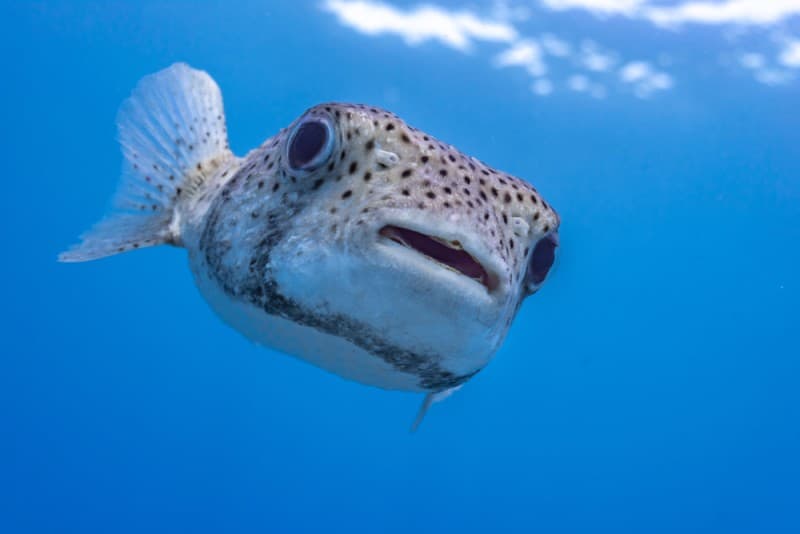
Puffers are any of the many fish species belonging to the Tetraodontidae family. In the family, there are around 90 species.
These species, which are mostly marine and estuarine and inhabit brackish and oceanic waters, go by several names, including swellfish, pufferfish, balloonfish, and blowfish. In some instances, they could live in freshwater too.
Interesting fact: Due to their amazing capacity to greatly inflate themselves with air and water to take on the appearance of a glob when disturbed or threatened, pufferfish are also known as balloonfish or swellfish.
Warm and moderate climates may be found worldwide for these species. These contain four somewhat big teeth that have fused into an upper and lower plate, and they usually have robust, prickly skins.
Their split jaws create a beak-like shape when their fused teeth, which are the source for their scientific name (Tetraodontidae), come together. Though most are much smaller, the giants of the species reach lengths of up to 90 cm (3 feet).
Eaters of crustaceans and mollusks, pufferfishes are carnivorous. To break through the tough shells of their food, they have evolved specialized teeth.
Poisonous is the term for the majority of pufferfish, and several are considered to be among the world’s most deadly fish. Highly dangerous chemical called tetrodotoxin is found in the internal organs of some animals, such as the liver and sometimes the skin. Most animals cannot survive if they consume them.
It doesn’t matter; flesh from different puffers is consumed, especially in Japan where it’s made into the specialty fugu. Cooks with specialized training who know which portions of fish are safe to eat and how much is a sufficient amount must prepare the diet.
Because different puffers are so hazardous, the royal family stays away from the dish completely in the meantime. Hétún (a Chinese dish) and bogeo (a Korean dish) are made using puffer flesh.
Because eating pufferfish near Titusville, Florida, causes neurological problems in its consumers, the state of Florida has outlawed the gathering of puffers from a number of water bodies.
Supportive care is mostly used to treat pufferfish toxicity. For intestinal decontamination, it uses activated charcoal and gastric lavage.
Furthermore, until the poison is digested, the patient needs life support. A number of reports suggest that edrophonium and other anticholinesterase drugs might be useful in combating tetrodotoxin.
9. A red lionfish, (Pterois volitans)
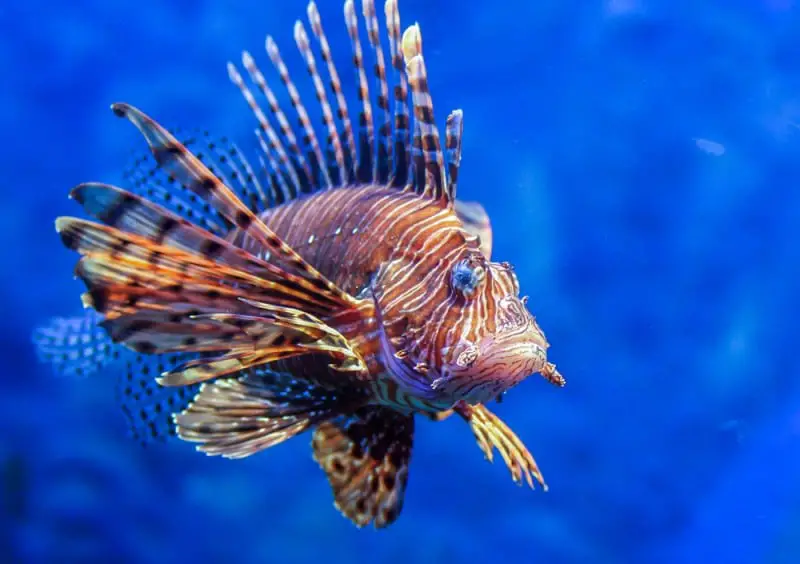
Native to the Indo-Pacific area, lionfishes, also called Pterois, are a group of colorful fish species. Members of the order Scorpaeniformes and family Scorpaenidae are the scorpionfish. The red lionfish, which is a well-known poisonous coral reef fish, is now an invasive species in the Caribbean Sea and other waterways around the US East Coast.
Fish hobbyists often keep the red lionfish, one of the most well-known Pterois species. As an adult, it is around 30 centimeters (12 inches) in length and has stripes of red, white, and brown. It possesses lengthy dorsal fin spines and expanded pectoral fins in addition to its noticeable zebra-like striping pattern.
Fun Fact: The massive, poisonous spines that protrude from the body of the red lionfish, like those on a lion’s mane, are shared by all lionfish species. The term “lionfish” was therefore born.
Its unusual dorsal spines, which are poisonous, assist the fish repel prospective predators and render it inedible. The red lionfish warns an attacker by spreading its fins and showing them, and if the danger continues, it rolls over and uses its spines to stingthem.
People who are envenomed suffer from a number of unpleasant symptoms, even if the sting is not lethal.
An attack by a lionfish might cause the following symptoms:
Extreme discomfort
Migraine
hurling
trouble breathing
Most hospitals don’t undertake particular treatments, thus the standard course of therapy is to soak the afflicted portion in hot water.
It reproduces quickly, especially for red lionfish. Together with the lack of natural enemies in the Gulf of Mexico and the East Coast, it has become established as an invasive species and drastically decreased the number of reef fish in the area.
Lionfish are often voracious hunters who hunt from late afternoon till the next day. They have even been known to outcompete other fish species that are predators. Using their big fins to corner their target, they hunt by swallowing the whole prey with lightning-fast reflexes.
A major contributing factor to the present trend of declining fish numbers may be the red lionfish’s expanding population and high rates of prey consumption. As a result of their invasiveness, they are now endangering fragile ecosystems.
8. Candiru (Vilda cirrhosa)
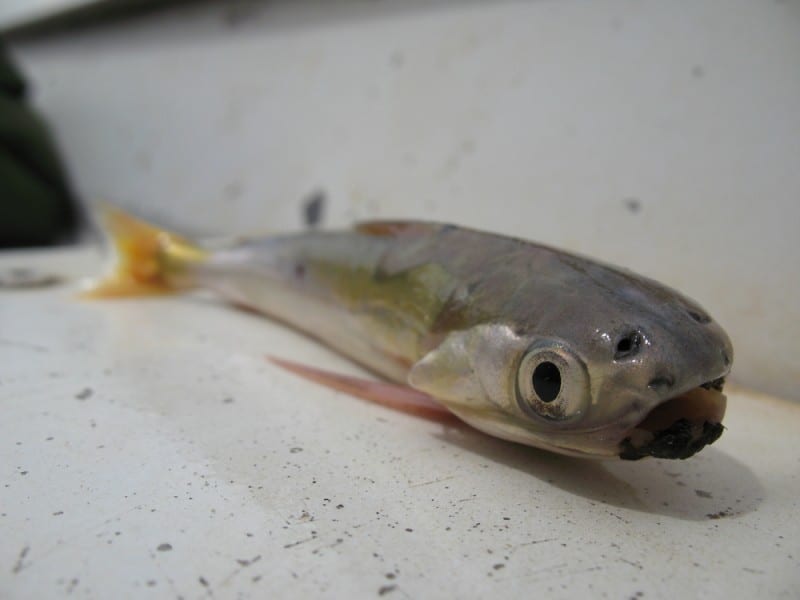
Within the Trichomycteridae family of freshwater catfish, the candiru, commonly referred to as vampire fish, is a scaleless parasitic fish. The following are indigenous to the region around the Amazon River:
Brazil, Ecuador, Colombian, India, and Bolivia.
Eels are resembled by candirus, which are transparent. Smaller species may reach a maximum size of one inch, or around 2.5 cm.
Additional typical candirus traits are as follows:
brief sensory barrels encircling a tiny head
Reversible spines on gill coverings
A visibly enlarged abdomen
Their usual home is the gill chambers of bigger fish, where they feed on blood. It is still debatable whether candirus can enter human urethras, despite the fact that it is generally believed to infiltrate the urethras of aquatic species.
There have been several reported examples, some as far back as the 19th century, of smaller candirus species entering and parasitizing the human urethra. That being said, it is still up for debate that the first surgical removal of a candiru from the human urethra was performed in 1997.
The sharp spines on candirus’s gill covers cause bleeding and hemorrhage, as well as perhaps the victim’s death, when it enters the host animal’s passageway.
The transparency of these fish species’ bodies makes it difficult to identify them in the murky waters in which they live.
Being mindful of untreated natural freshwater might be beneficial.
7. Great White Shark (Carcharodon carcharias)

One of the world’s most formidable and potentially lethal predatory sharks, the great white shark is also known as the white shark or white pointer. We don’t need to introduce this beast because of Steven Spielberg’s Jaws (1975). The great white shark’s existence and habits are mostly unknown, despite the fact that it is a much discussed species and is feared by the public.
On the nearshore surface of all the world’s major oceans, there exists a significant species of mackerel shark.
Unusual fact: Sharks are thought to be the biggest species of macropredator fish on the planet. At maturity, the females weigh between 1,905 and 2,268 kilograms (4,200 and 5,000 pounds) and may reach a maximum height of 6.1 meters (20 feet).
According to a 2014 BBC study, white sharks are among the longest-living cartilaginous fish, with a potential lifespan of up to 70 years or more. From the mid-Miocene Epoch era, around 12–18 million years ago, according to the fossil record, white sharks have existed now. Yet, it’s possible that their ancestors existed between 56 and 34 million years ago, during the Eocene Epoch.
Despite not being white pointers’ preferred food, these fish are accountable for the majority of documented and seen instances of lethal unprovoked shark attacks on people. In places where they are most common, they prey on swimmers, kayakers, surfers, divers, and small boats.
With typically less than ten occurrences annually globally, these assaults are rather uncommon. Although they usually only attack humans once before moving on, great white sharks may come back to bite.
An human may have time to escape to safety if the shark bite is modest. On the other hand, severe bites might harm the victim’s organs and tissues, which would eventually be fatal.
According to an analysis, around 7% of great white shark attacks on people in the western United States resulted in fatalities. The death toll was greater in other regions of the globe, however, with Australia recording as many as 60% of casualties and South Africa surpassing 20%.
Many scientists believe that people are the reason why sharks attack humans. In contrast, other researchers believe that shark attacks happen when sharks confuse people for seals and sea lions, which are the sharks’ natural food. When they cannot find their typical prey, sharks may occasionally try to attack people.
6. Moray Eels (Muraena)
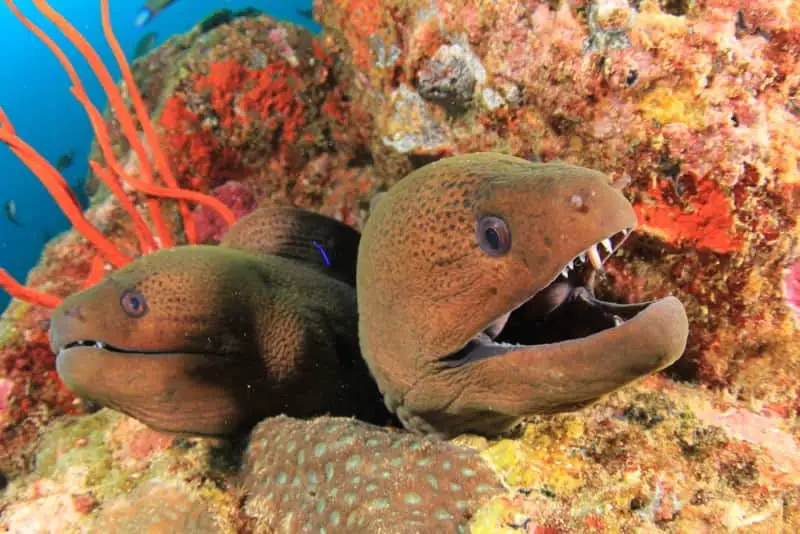
Worldwide marine waters are home to the moray eel family of eels. Over eighty species of moray eels are known to exist today. Shallow waters between rocks and reefs are where they hide in ravines and inhabit tropical and subtropical oceans.
Moray eels may grow up to 1.5 meters (5 feet) in length, on average.
Its dorsal fin connects the caudal and anal fins together smoothly, extending from behind the head across the back. Because they lack pelvic and pectoral fins, the majority of moray eel species have a serpentine look. Morays’ keen sense of smell is their primary means of prey detection due to their very tiny eyes.
Moray eels are characterized by their smooth, thick skin devoid of scales, and their typically patterned bodies. The inside of the mouth is patterned in a few species as well.
At the tips of their prominent snouts, they also have wide mouths. Their big, pointed teeth are used to rip flesh and grab slick prey inside their jaws. When they attack, even people, they may also do serious harm to them with their teeth.
Only when they feel threatened will moray eels try to attack humans. Then they start acting a little aggressively. However, Thyrsoidea macrurus, which reaches a maximum height of around 3.5 meters (11.5 feet), is an exception.
In many places, including ancient Rome, where Muraena helena was a highly prized delicacy, moray eels are consumed. Unfortunately, because of the risk involved, eating moray eels is not advised.
Ciguatoxins are found in high concentrations in a number of moray species, including the big moray and yellow-edged moray. Hepatocellular toxins are the most prevalent.
A case of ciguatera, or moray eel poisoning, presents with the following symptoms:
neurologic issues
gastrointestinal conditions
cardiovascular problems
5. Tigerfishes
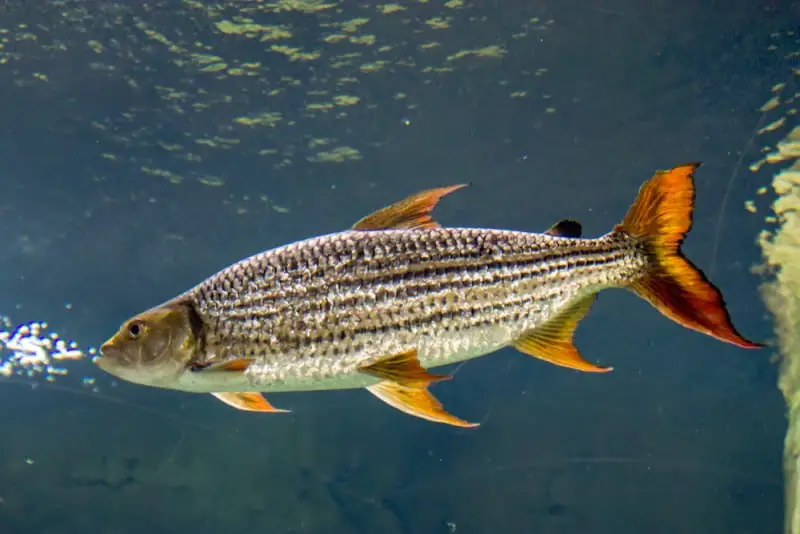
A variety of fish species are included in the word “tigerfishes”.
Based mostly on the following criteria, they are named:
Their hostility at being discovered
Their environments, which are very predatory.
Their look
African freshwaters are home to a large number of species of the genus Hydrocynus (Hydrocyon). They’re in the order Cypriniformes, among the Characin family (Characidae).
Their distinguishing characteristic varies according on the species, although they are usually noticeable. A black stripe along the length of them is another feature.
Salmon-shaped predators, tigerfish are swift and lustful. Their mouths are closed, yet their teeth stick out like daggers.
The biggest species of African tigerfish is Hydrocynus goliath, which can reach lengths of up to 1.8 meters (6 feet) and weights more than 57 kilograms (125 pounds). There are around five species of similar fish. Alternatively, one of the world’s best game fish is the tiny Hydrocynus vittatus.
Water and marine tigerfish of the Perciformes family Theraponidae are found in the Indo-Pacific area. About 30 centimeters (12 inches) vertically lined is one common species of tigerfish, the three-striped tigerfish (Therapon jarbua). The gill covers of these fish are covered with sharp spines that may cause harm to anybody who assaults them or handles them negligently.
With their razor-sharp teeth that interlock and their powerful physique, African tigerfish are fierce predators that often hunt in groups, much like piranhas.
Important Information: Only freshwater tigers have been seen to target and capture avian prey while they are in flight.
4. Pygocentrus piranha,
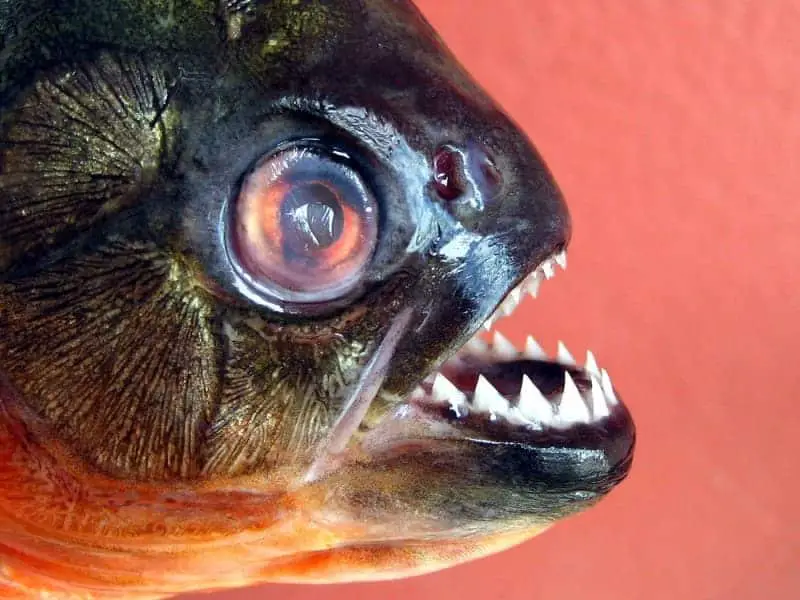
The genus Piranha is made up of more than sixty species of native South American freshwater fish, particularly those found in the Amazon River, that have sharp teeth. Most species are herbivores or scavengers and never grow larger than 60 centimeters (2 feet), despite the portrayal of them in the 1978 film Piranha as rapacious, violent murderers.
Piranhas often have the following characteristics:
profunde bodies
bellies with saw-edges
hefty, blunt heads
strong jaws that meet in a scissors-like bite with sharp, triangular teeth.
With teeth that may reach a maximum length of 50 centimeters (20 inches), the red-bellied piranha (Pygocentrus nattereri) has the strongest jaws. It hunts in groups of up to one hundred individuals in deep water. Spread out in their search for meals, red-bellied piranhas choose smaller or slightly bigger prey.
Interesting Fact: Since piranhas have exceptional hearing when an attacking scout in a group of piranha hunters finds a game, they may alert the others by making noise. Then everyone in the gang goes over to the game, has a mouthful, and then swims off to make place for some more.
The lower Amazon tributaries and Orinoco River basin are home to another species of piranha, Pygocentrus denticulate, also known as the lobetoothed piranha. Pygocentrus piraya, often known as the San Francisco piranha, is indigenous to Brazil’s San Francisco River. People are at risk from both animals.
Though they seldom attack persons, the majority of piranha species never kill large animals. Their assaults are fierce. Most animals scavenge more frequently than they kill, despite being drawn to the scent of blood.
3. The stonefish (Synanceia verrucosa)
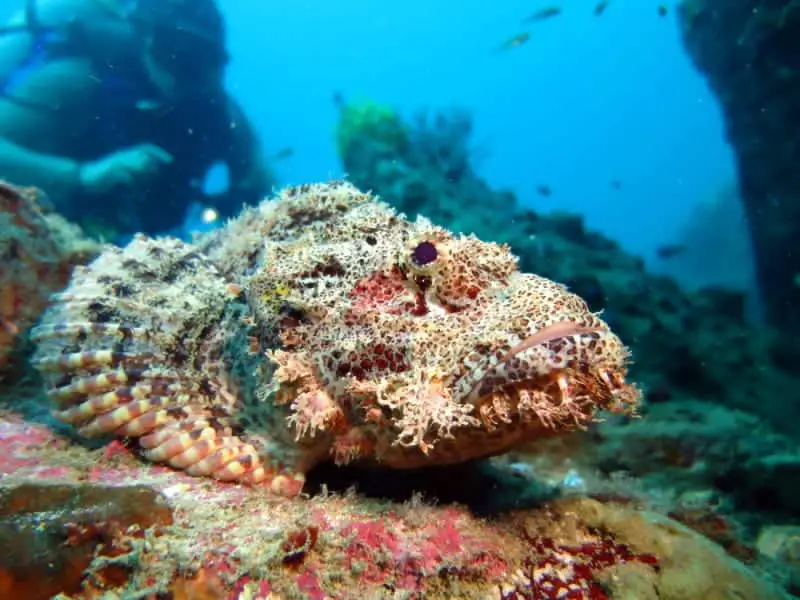
They are found in the shallow seas of the tropical Indo-Pacific region. They are slow-moving aquatic creatures that reside in muddy estuaries, amid rocks or coral.
Among stonefish’s many traits are:
enormous heads and mouths
little eyes
wart-like bumps on rocky skin
Tissue-like folds
Thickset fish blend in with their environment via shape and color as they lay immobile on the bottom of bodies of water. Notably, these fish are deadly and live in obscure locations.
Dwelling on their dorsal-fin spines, they deliver venom dosages into humans when they tread on them. The ensuing wounds may be lethal at times and are very painful.
2. Atlantic Manta Rays (Mobula)
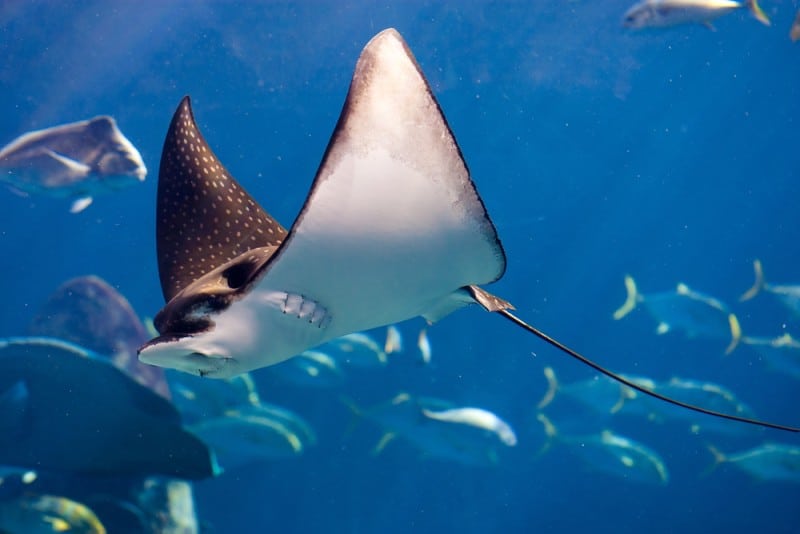
Manga rays belong to the Mobulidae family of Chironomidae. Marine rays of many kinds are grouped together under the name manta rays or devil rays.
Large, fleshy pectoral fins that resemble wings are seen on their flattened, wider than length segments. The front part of their heads has projections on their pectoral fins that resemble a devil’s horns.
Moreover, certain species of devil rays have short, whip-like tails covered with stinging spines. Across continents and islands, they live in warm seas and are connected to skates and sharks.
They can swim at or near the water’s surface because they can flap their pectoral wings to propulsion. They sometimes spring or somersault out of the water, snatching plankton and small fish with their cephalic fins and eating them.
Only 60 centimeters (2 feet) is the maximum size of the smallest species of manta ray, Mobula diabolis, an Australian cartilaginous fish. Nonetheless, the Atlantic Manta (Mobula birostris), sometimes referred to as the gigantic devil ray or just the ocean manta ray, may reach a width of more than 7 meters (23 feet).
The renowned brown or black ray species are known as Atlantic mantas. When they are not threatened, they are very strong yet non-aggressive. They don’t engulf and consume divers, unlike what is often believed.
The brains of Atlantic manta rays may weigh up to 200 grams, which is five to ten times more than the brains of whale sharks. This is a fun fact about fish. Compared to other fish that are presently known, they have the largest brain-to-mass ratio. As one of the few creatures that could pass the mirror test, they seem to be displaying self-awareness. Additionally, they warm the blood that travels to their brain.
1. Electric eel (Trophorus electricus)
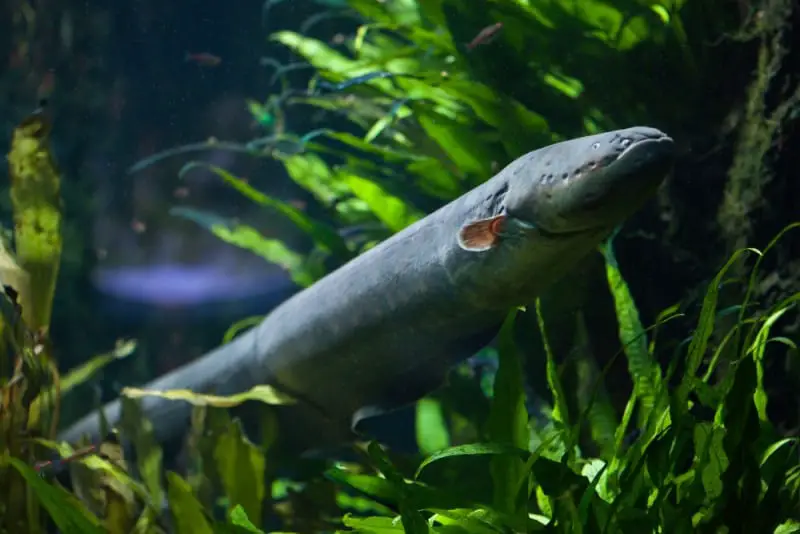
Native to South America, the electric eel is a long, cylindrical fish. To render its victim—usually other fish—immobile, the fish delivers a strong electric shock. Grows to 2.75 meters (9 feet) in height and weighs 22 kilograms (48.5 pounds) with a long, scaleless body that is mostly gray-brown with an occasional crimson underbelly.
Making up almost four-fifths of the whole length of the electric eel, the tail region is the longest. An elongating anal fin that serves as the creature’s prop is situated along its bottom.
Electric eels, despite their name, are not really eels. These are really knifefish, which are more closely related to characin fish, which also include neon tetras and piranhas.
Within the várzea, an Amazonian forest with whitewater flooding, electric eels are among the main aquatic predators. It was discovered that electric eels accounted for about 70% of the fish biomass in fish research conducted in the Várzea forest.
Fish of this kind are usually slow-moving and favor freshwater environments, where they often surface to take a breath. They can utilize their mouths as lungs because of the abundant vascularization in them.
One interesting fact is that the Electrophorus electricus produces electricity using three pairs of abdominal organs. Sach’s organ, Hunter’s organ, and the main organ are among them. The electric eel can deliver both high- and low-voltage electric shocks because to its electrolyte composition.
Perhaps in an effort to shield their sensitive lips from damage caused by battling spiny fish, electric eels have evolved the ability to shock their prey. As a result, the stunned prey becomes confused for a sufficient amount of time to allow the electric eel to suction it directly into its stomach via its mouth.
The electric eel may sometimes swallow its victim before they have a chance to respond, instead of shocking them. It is also possible to use the electrical discharges to keep away prospective games or to cause hidden prey to tremble and reveal its position.
Spinal nerves innervate electric organs found in the tail portion of an electric eel, which are derived from muscle tissue. With a powerful enough charge to startle people, these organs release between 300 and 650 volts of electricity.
Multiple shocks to the electric eel may cause respiratory or cardiac collapse in humans, even though electric eel shock fatalities are uncommon. After receiving an abrupt and startling shock from an electric eel, humans have also been known to drown in shallow water.
A List of Common Questions (FAQ)
Which fish species is the world’s most dangerous?
Being able to shock people with electric shocks makes the electric eel the most lethal fish in the world.
Which river fish species worldwide poses the greatest threat?
Among the world’s most hazardous river fish are piranhas, a kind of predatory fish with sharp teeth that live in the Amazon river.
Which freshwater fish species is the world’s most dangerous?
The world’s most hazardous freshwater fish are piranhas and electric eels.
Which marine creature is the most deadly?
Stonefish are considered the most hazardous fish in the water due to their strong venom that may inflict severe pain or even death to humans.
Which fish poses the most risk for consumption?
Due to the high concentration of poisons in their internal organs, moray eels and puffers are not recommended for consumption.
Final Thoughts
Although fish seem to be the most defenseless group of vertebrates, there are really a number of very hazardous and self-defending species. In order to avoid hazardous or even deadly fish attacks, people should use caution while swimming and when traveling by boat or ship.
Applying care while handling dangerous fish species is crucial for fishermen, fish enthusiasts, and ichthyologists. But more significantly, victims of fish attacks should get therapeutic or medical assistance as soon as possible.


![13 Beautiful Birds in Mexico [Images + IDs]](https://birdsology.com/wp-content/uploads/2024/01/magnificent-frigatebird-600x400.jpg)



Buy Private proxies: BEST PRIVATE PROXIES – Snobs outstanding, Endless bandwith, 1000 mb/s superspeed, 99,9 uptime, Low sequent IP’s, Not any intake regulations, Numerous subnets, USA and even European union proxies – Pay for At this point – https://DreamProxies.com